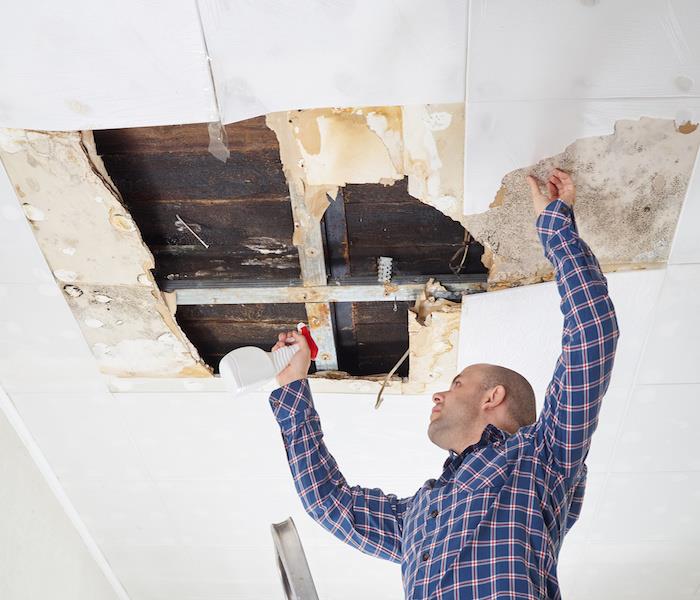Mold Cleanup Methods
5/2/2016 (Permalink)
If you have mold in your home, it’s important that you have the professionals at SERVPRO handle the cleanup or remediation. The process of cleaning up mold can be complicated and dangerous if you’re not trained to do the job properly. Also, due to the fact that dead mold can still be dangerous to your health, it must be removed rather than killed.
Mold typically occurs in buildings when there is an excess of moisture or water present and can grow on virtually anything. Therefore, the purpose of mold remediation is to correct the moisture problem and to rid the building of moldy or contaminated materials. This will prevent human exposure to the mold and any further damage to the building materials or furnishings.
If porous materials have become wet causing mold to grow on them, they may need to be discarded because molds can penetrate porous materials growing on or filling in the empty spaces or crevices. This type of mold can very difficult or seemingly impossible to completely remove.
Even in dead mold, chemicals and proteins that can cause a reaction in humans are present so killing the mold with biocide isn’t enough. It must be removed. There are a variety of cleanup methods that can be used to remediate potential damage to building materials and furnishings. Which method is chosen depends on the type of material that’s been affected by the mold.
Wet Vacuum
Wet vacuums are vacuum cleaners that are designed specifically to collect water. These can be used to remove water from floors, carpets, and hard surfaces where water has gathered. These vacuum cleaners are used on wet materials only as the spores could be exhausted into indoor environments if there isn’t enough liquid present. Any tanks, hoses, or attachments of the vacuum need to be thoroughly cleaned and dried because the mold or mold spores may adhere to equipment surfaces.
Damp Wipe
Wiping or scrubbing with water and detergent can usually remove mold from nonporous surfaces. The surfaces should be dried quickly and thoroughly to discourage further mold growth. Product labels have instructions for the cleaning surfaces which should always be read and followed.
HEPA Vacuum
High-efficiency particulate air (HEPA) vacuums are recommended for the remediation area’s final cleanup once the materials have been dried and all of the contaminated materials have been removed. For any dust that may have ended up on the surfaces outside of the remediation area, HEPA vacuums are recommended. When using the vacuum, the filter must be properly seated in the vacuum to ensure that air passes through the filters.
Remediators changing the vacuum filter should be wearing respirators, appropriate personal protective clothing, gloves, and eye protection in order to avoid being exposed to potentially captured mold or other contaminants. When finished, the filter and any contents must be disposed of in impermeable bags or containers which is important in preventing the release of any debris.
Disposal of Damaged Materials
For those building materials and furnishings that have been contaminated with mold growth and are not able to be salvaged will be placed in impermeable bags or closed containers while they remain in the remediation area. These materials can usually be discarded as ordinary construction waste. When discarding these mold-contaminated materials, they’ll be packaged to minimize the dispersion of mold spores.
Large items that have suffered heavy mold growth will be covered with polyethylene sheeting and will be sealed with duct tape prior to being removed from the remediation area. For some jobs dealing with large quantities of debris, dust-tight chutes place strategically outside a window in the remediation area might be required to move the debris to the dumpster.
Use of Biocides
Biocides are toxic to animals and humans so when using disinfectants or biocides, the room will always be ventilated using outside air. This will exhaust the air to the outdoors. If fans are used, the remediators will take care not to extend the zone of contamination by spreading the spores to other areas.
Since some biocides are considered pesticides, some states require that those applying these products in schools, commercial buildings, and homes be registered pesticide applicators. Any fungicides that are meant for outdoor use shouldn’t be applied indoors as they can be extremely harmful to animals and humans in an enclosed environment.
The existence of mold in your home can be a health risk to you and your family. The process of eradicating the mold is complicated and can cause more problems if it’s not done properly. If you have in your home, call the professionals at SERVPRO to ensure complete mold remediation.






 24/7 Emergency Service
24/7 Emergency Service
